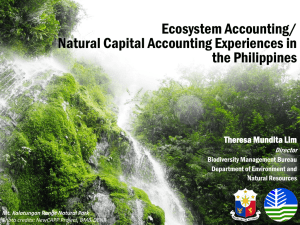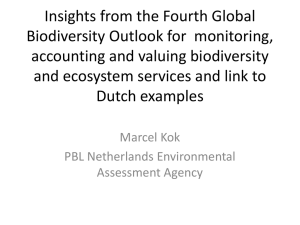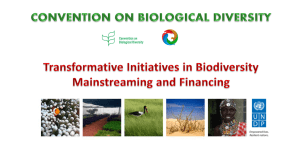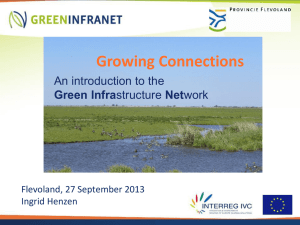Env markets for ecosystem services
advertisement
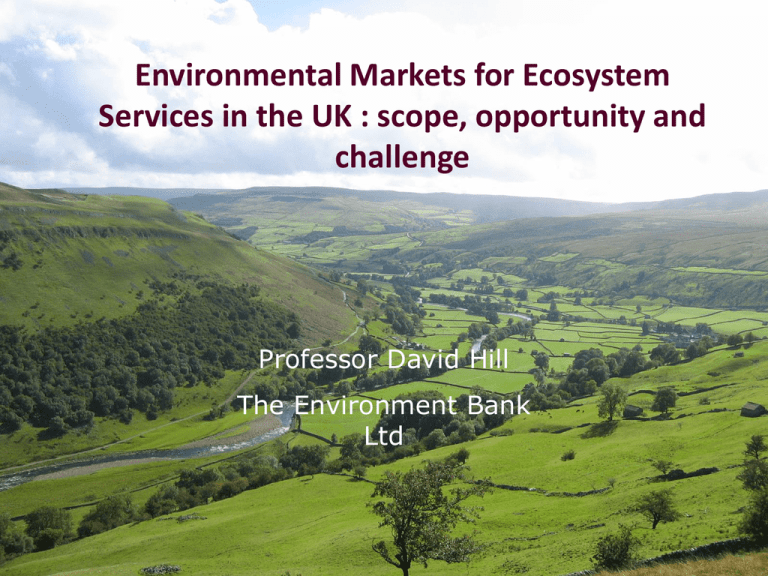
Environmental Markets for Ecosystem Services in the UK : scope, opportunity and challenge Professor David Hill The Environment Bank Ltd I shall outline …. • • • • • • • Importance of valuing nature Market intelligence Market size - scope for growth Science, evidence and policy Public and private investment Ecosystem Markets Taskforce Key challenges and next steps Nature provides us with : • • • • • • • • • Food Water Fibre and materials Biodiversity and landscape Minerals Fuel Flood alleviation Means of holding carbon Our climate Costs of Nature • Natura 2000 network - 26,000 sites, 18% EU territory; management costs €5.8bn/yr • Total EU funding available for biodiversity 2007-13 = €1.3bn/yr • Globally cost estimates of protecting 15% land, 30% marine = $45bn/yr (IUCN) • Total biodiversity protection estimate = $290-385bn/yr (Parker & Cranford 2010); Actual spending = $3638bn/yr • Sustainable Responsible Investment assets = c.€5 trillion Info from Eftec (2011) report to EU Value • Few ecosystems being explicitly priced • Priced ones only reflect direct-use values (crops, fish ie directly consumed) • Non-use values eg cultural - concerned with a species or habitat are almost never priced • Indirect-use values eg regulating services, only recently starting to be valued • We need an all-encompassing economic valuation of benefits to society derived from BES = better appreciation of financial implications and costs of BES loss and degradation from misuse and overexploitation Environmental markets • Internationally there is mounting interest in environmental markets from credit buyers, regulators, investors, environmental community • Emerging recognition of natural resource stewardship and restoration as a dynamic area for investment • Transforming biodiversity from a risk and liability problem into viable profit-generating business opportunity Carol, Fox & Bayon (2008) Conservation & Biodiversity Banking. ‘Innovative private sector mechanisms to finance and encourage sustainable management of BES are developing, given the imperatives of increasing natural resource scarcity, continuing BES degradation and loss and potentially damaging consequences of such loss for society and the economy’ von Gunten, C. & Cooper, M. (2011). Finance, biodiversity and managed ecosystems. Where’s the data? Report to NERC by Z/Yen Group. MARKET SIZE : Scope for growth Estimates for emerging biodiversity and ecosystem service markets (derived from Ecosystem Marketplace) are presented in the table in the slide drawn from the TEEB report looking at potential global growth to 2020 and 2050 compared to present day. The TEEB report for business concludes that new markets for biodiversity and ecosystem services are emerging and if scaled up, these markets could represent major business opportunities and a significant part of the solution to the ecosystem and biodiversity finance challenge. QuickTime™ and a decompressor are needed to see this picture. Value = $5 - 10bn p.a Tradable credits in the US • • • • • • • • Wetland mitigation credits Habitat conservation credits Water quality credits - N, P, sediments Bundled biodiversity credits Marine biodiversity credits Natural resource damage credits Mangrove credits Etc….. Scope for private investment : CR markets • Markets in : forest products, sustainable forestry, emissions offsets, watershed mgt, flood risk mitigation, ecotourism, biodiversity, nutrients • Likely to develop ahead of regulated offsets • Integrating BES risks and opportunities into corporate planning and decision making • Providing corporate licence to operate • Increased customer loyalty • Better staff recruitment • Sustainability in supply chain • Reduced investment and reputational risks • Improved profitability and investment value • Accessing new sources of capital What is needed to grow emerging markets • Good regulatory framework to enhance purely voluntary mechanisms - create level playing field, provide stability • Standardised metrics • Accreditation of suppliers of offset and ecocredits • Clearly defined asset classes • Cooperation between science, finance and on-theground delivery • Verification, registry, tracking of credits and enforcement • Environmentally experienced brokerage system trading platform (Environment Bank) Science, evidence and policy • Need good spatial datasets of ecological resources (already exist ?) • Where are Ecosystem Services - categorise to 4 NEA definitions • Use these to calculate ES impacts from eg development/land-use change • Convert these via offset-metrics to Ecocredits • Do we need 100% confidence ? No. Adaptive management Opportunities : Policies we can use • Natural Environment White Paper • National Ecosystem Assessment • Environmental Liability Directive - turn into economic cost of restoring environmental damage - direct economic value of BES • Potentially offset purchase/credits through Water Framework Directive • CR - construct credits that can be purchased by corporates; create bonds from offsets that attract investors Natural Environment White Paper • Environment is foundation of sustained economic growth • Markets, business and government to better reflect the value of nature - on the balance sheet • There are £m-multi opportunities available from markets that protect nature’s services • Expanding markets and schemes for payments by beneficiaries to providers of ecosystem services • An Ecosystem Markets taskforce to expand trade in green goods and market for sustainable natural services • Biodiversity offsetting embedded within the planning system Public vs private..and partnerships • Set by Government – Environmental priorities and policy – Metrics/ Standards – Local government cooperation – Regulatory framework – Validation of credits – Speed up processes – Work with private sector • Provided by market – Offset providers (KDB’s) – Applying metrics to determine credit requirement – Credit certificates – Registry tracking of credits/sites – Trading infrastructure – Monitoring evaluation – Contractual obligations Opportunities for Pilots The Shell Foundation and Environment Bank • The Shell Foundation has invested in The Environment Bank to scale up the idea from biodiversity offsetting to markets for ecosystem services in the UK and potentially Europe • Capacity building - securing pilots - building stakeholder relations - applying metrics for offset sites and developments - infrastructure for registering sites and enabling credit purchasing - legal documentation for running conservation banks Conservation Credits Exchange ECOSYSTEM MARKETS TASK FORCE As our understanding of the value of natural capital grows (e.g. UK NEA/TEEB), there is a natural progression to reviewing the scope for new approaches to ‘capture’ value The challenge is to harness these values so they can also become real commercial values Available estimates point to a significant potential for longterm growth in emerging markets in biodiversity and ecosystem services Strong link to broader work on green economy and role that environmental markets could play EMTF TERMS OF REFERENCE • Assess market opportunities - where UK business has a competitive advantage • Greening current products and services as well as creating new ones • Clear view of economic and environmental benefit • Scope for market development and value creation -current drivers of greener market growth • Role of the financial sector - potential for new privately funded green investment vehicles • Do markets have the required elements to function? • Prioritise actions to enable and secure market opportunities Key challenges • Better use of regulation = market growth, combined with voluntary markets • Defining ES to society • Making the use of ecosystem services economically visible cross all sectors • Putting effective infrastructure in place within a short timeframe eg public (eg accreditation schemes, metrics) and private (eg EBL trading exchange) • Need to get investment going NOW - too much at stake to wait • Recognising some things can be done by government; some things by the private sector Next steps…. • Pilot schemes for BES generating income streams by a) offsets, b) corporate responsibility investment • Investigate use of environmental bonds - generating investment eg uplands for C, H2O, biodiversity (multipurpose bonds) • Where will corporate growth most acutely align with securing fully functioning ecosystems? • How can regulatory markets be best created planning system, WFD, ELD, others? A simple message …. • We need a major gear shift to restore and enhance biodiversity and ecosystem services • We need to move from a position of simply seeing the environment as a charitable exercise • Policies need one focus above all - enabling financial markets to properly value the natural environment so that it receives the necessary investment www.environmentbank.com
